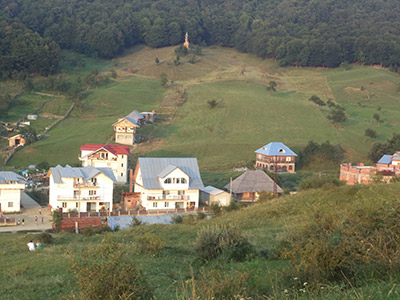Trip Report – Alternative Summer Break in Romania

On August 10, 2014, four COE students traveled to Bucharest, Romania, for the Alternative Summer Break. Students involved were Robert Minneci, materials science major; Kelli Grissom, civil engineering major; and Jon A. Jones and Bryan Eldreth, both majoring in chemical engineering. Judith Mallory, COE International Coordinator, led the trip, which was provided by United Planet of Boston.
Read about Bryan Eldreth’s experience in Romania »
Read about Robert Minneci’s experience in Romania »
Read about Kelli Grissom’s experience in Romania »
Read about Jonathan Jones’ experience in Romania »
The group stayed two hours outside of Bucharest in a rural village called Valea Screzii in the Transylvania region. The village was founded by an NGO called Pro Vita, formed by an Orthodox priest, in order to help orphans, single mothers, the elderly, and intellectually disabled adults. Pro Vita serves about 400 individuals, one-half of whom are children. The residents are split about evenly between Vilea Screzii and a neighboring village. Valea Screzii is composed of houses, each donated by an outside source, and includes a small farm including pigs, horses, cattle, and chickens. There are also dogs and cats for the children to play with, and several playgrounds and garden areas. Everyone who is able has some sort or job or chores to complete around the compound. Residents are housed with a mother figure in the houses, to avoid an institutional feel. Children are not adoptable by anyone other than Romanian citizens. The children ride a bus to school off-site.

The prevailing religion in the country is Romanian Orthodoxy, an Eastern Rite church. They were preparing for a holiday, and therefore were “fasting”, which meant no meat or dairy. Therefore, most of the food served during the week was vegetarian, much of it produced on-site, and all of which was very good.
The actual service project was about forty-five minutes away by car, and is a dormitory, under construction for high school students. Currently, the children in high school spend three hours on the bus each day, and the bus tickets are expensive. When the dormitory is complete, the high school group will move there with some of the mothers and be able to take a five-minute walk to school. There will be adults hired to help with tutoring, as some of the children had been living on the street when they first came to Pro Vita and had missed some schooling. The facility will be home to thirty-five students and five adults. If the students choose to go to university, which is in Bucharest, they will have a room at the facility when they come home for weekends.

At the project site, the COE group mixed concrete in a bucket loader, which had the capability of delivering the concrete to the second floor, where it was spread accordingly. The building is being built to earthquake standards, as Romania is in an earthquake zone. The ceilings are even made of concrete. The exterior of the building is currently shale brick, which will be covered with some sort of insulating material and then painted.

An architect from Pro Vita explained that after the fall of Communist regime, there was a building boom, and building codes and standards were largely ignored. They expect an earthquake every 30–40 years, and the last one was in 1977. It measured close to a seven on the Richter scale. Architects therefore conclude that about half of the buildings in the country will be destroyed in the next quake.
The other project for the COE students consisted of construction of a concrete pad by the church which can be used for parking or a basketball court. They had access to an ancient, electric cement mixer. One day the temperature reached a high of 114 degrees Fahrenheit, so work was delayed until later that evening.
The first side trip was up to the Carpathian Mountains, to several towns, the first of which was Sinaia, to visit Peles Castle, the former summer home of the Royal Family. Built around 1850, it was fully electrified and plumbed, including a central vacuum system, which is still operable. From there, the group traveled over to the town of Bran to see the Castle of Vlad the Impaler, purportedly the inspiration for Bram Stoker’s Dracula. It dates from the twelfth century. The final stop on the tour was to the town of Brashov for some sightseeing.
The final excursion was back to Bucharest, where the group visited the Village Museum, and outdoor interpretive center depicting examples of folk life, including buildings, tools, and equipment, from all of the areas of Romania. The next stop was to the House of Parliament, also known as “The People”s Palace,” the second-largest government building in the world, behind the US Pentagon. It was begun by former dictator Nicolai Ceausescu, who was executed before ever getting to use it.
The group departed Bucharest early the next morning, for a return flight to the United States.
